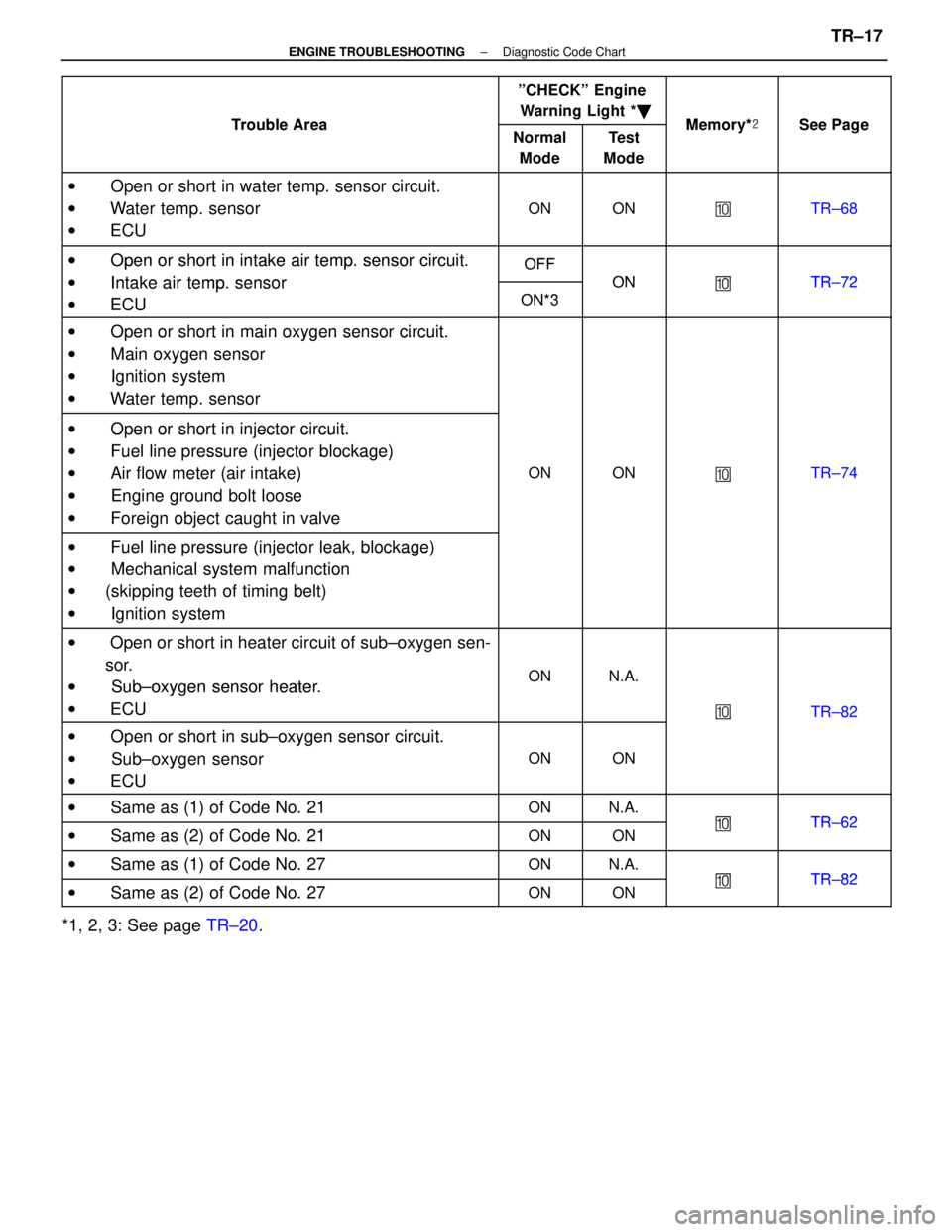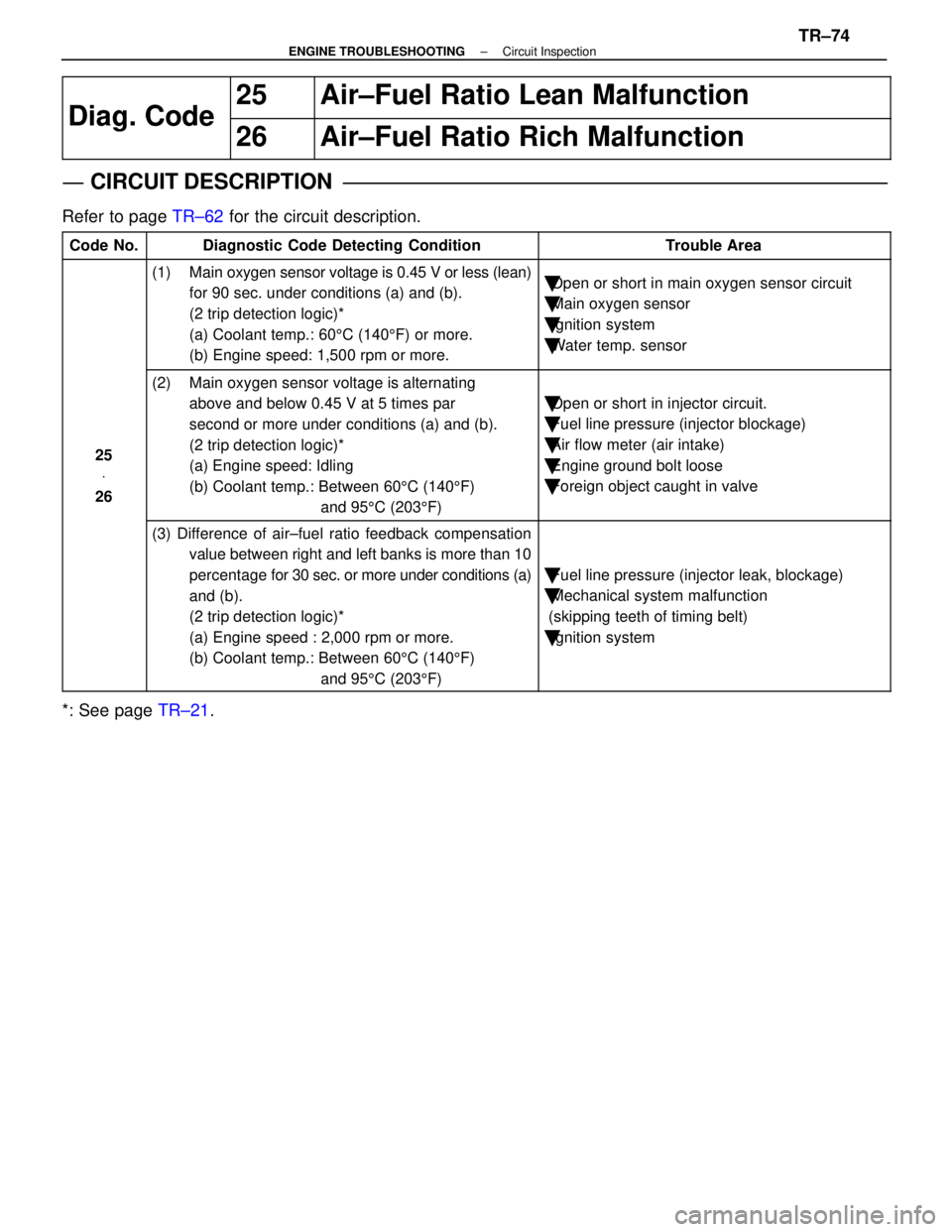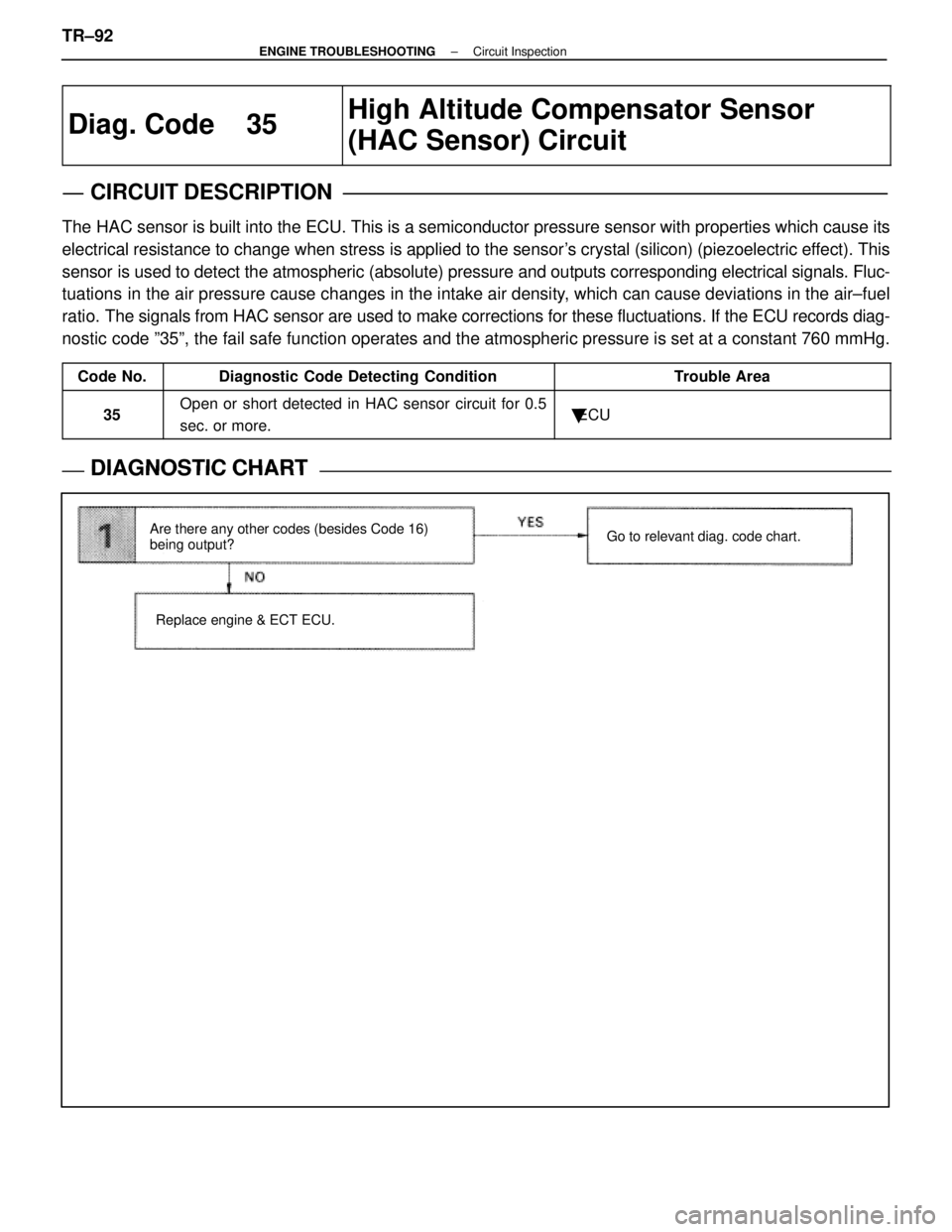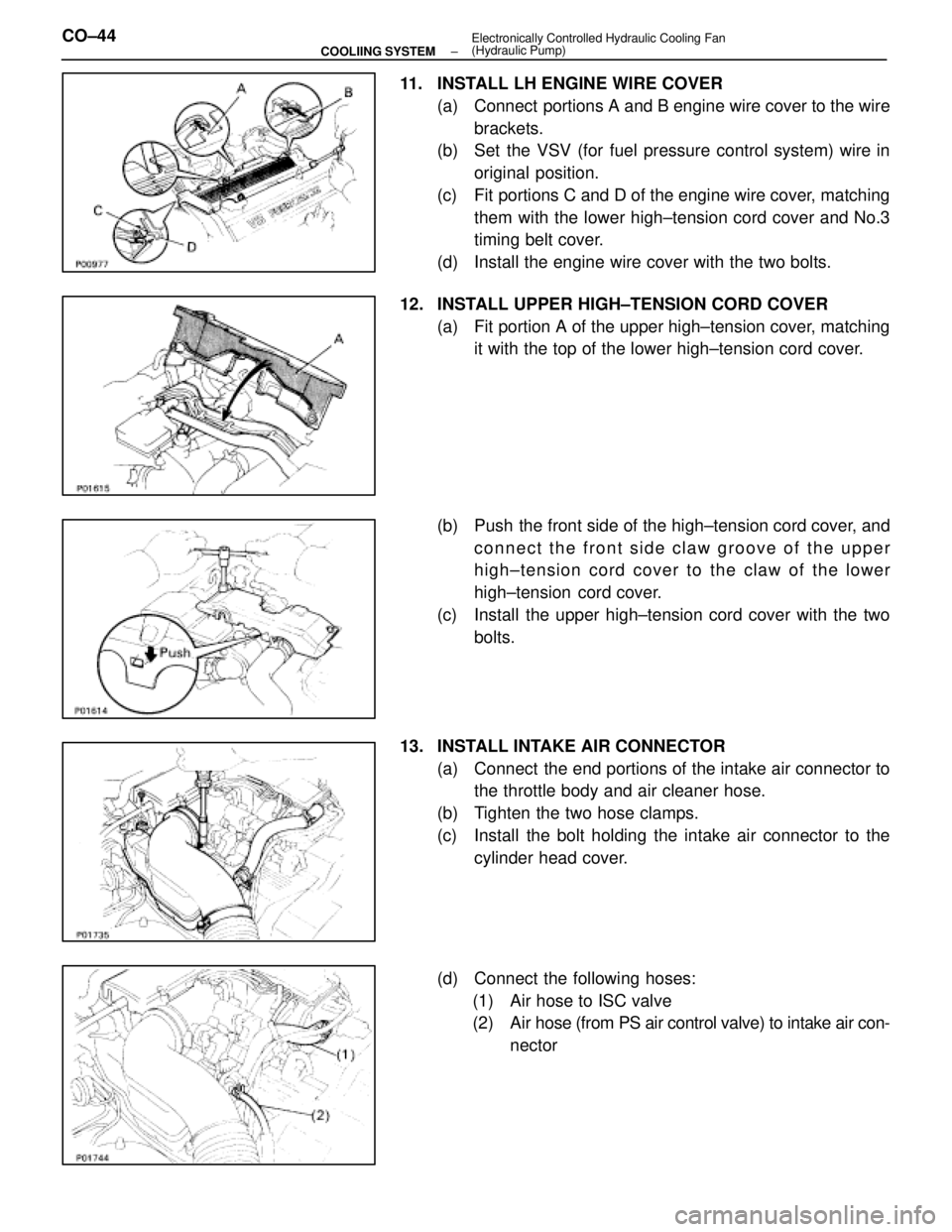Page 2628 of 4087

ºCHECKº Engine
Tro ble Area
CHECK Engine
Warning Light *�Memory*�See PageTrouble AreaNormal
ModeTest
ModeMemory* �See Page
w Open or short in water temp. sensor circuit.
w Water temp. sensor
w ECU
ONON�TR±68
w Open or short in intake air tempsensor circuitOFFw Open or short in intake air temp. sensor circuit.
w Intake air tempsensor
OFF
ON�TR 72w Intake air temp. sensor
ECUON*3
ON�TR±72
w ECUON*3
w Open or short in main oxygen sensor circuit.w Oen or short in main oxygen sensor circuit.
w Main oxygen sensor
Main oxygen sensor
w Ignition systemgy
w Water temp. sensor
w Open or short in injector circuit.w Oen or short in injector circuit.
w Fuel line pressure
(injector blockage)w Fuel line ressure (injector blockage)
w Air flow meter (air intake)ONON�TR±74 Air flow meter (air intake)
w Engine ground bolt loose
�
gg
w Foreign object caught in valve
w Fuel line pressure (injector leak, blockage)w Fuel line ressure (injector leak, blockage)
w Mechanical system malfunction Mechanical system malfunction
w(skipping teeth of timing belt)(g g)
w Ignition system
w Open or short in heater circuit of sub±oxygen sen-
sor.
w Sub±oxygen sensor heaterONN.A.w Sub±oxygen sensor heater.
w ECU
�TR±82
w Open or short in sub±oxygen sensor circuit.
�TR 82
w Oen or short in sub oxygen sensor circuit.
w Sub±oxygen sensor
ONON Sub oxygen sensor
w ECU
w Same as (1) of Code No. 21ONN.A.
�TR 62w Same as (2) of Code No. 21ONON�TR±62
w Same as (1) of Code No. 27ONN.A.
�TR 82w Same as (2) of Code No. 27ONON�TR±82
*1, 2, 3: See page TR±20.
±
ENGINE TROUBLESHOOTING Diagnostic Code ChartTR±17
WhereEverybodyKnowsYourName
Page 2633 of 4087

FAIL±SAFE CHART
If any of the following codes is recorded, the ECU enters fail±
safe mode.
Code No.Fail±Safe OperationFail±Safe Deactivation Conditions
14Fuel cut1 IGF1 detected in consecutive 8 ignitions.
15Fuel cut1 IGF2 detected in consecutive 8 ignitions.
16Torque control prohibited.Returned to normal condition.
22THW is fixed at 805C (176 5F).Returned to normal condition.
24THA is fixed at 20 5C (68 5F).Returned to normal condition.
31
Ignition timing controlled between 10 5 ~ 30 5
BTDC,
Injection time controlled between 3 msec. ~ 30 m
sec., in relation to:
w Engine rpm
w Throttle angle
w ISC step value
KS input 15 times/sec. or more.
35Atmospheric pressure is fixed at 760 mmHg.Returned to normal condition.
The following 1 or 2 must be repeated at least 2
times consecutively.
41VTA1 is fixed at 051 When IDL is ON41VTA1 is fixed at 051 When IDL is ON
0.25 V � VTA1 � 0.95 V
2 When IDL is OFF2 When IDL is OFF
0.25 V � VTA1 � 4.9 V
The following 1 or 2 must be repeated at least 2
times consecutively.
47Value of VTA1 is used1 When IDL2 is ON47Value of VTA1 is used.1 When IDL2 is ON
0.25 V � VTA2 � 0.95 V
2 When IDL2 is OFF2 When IDL2 is OFF
0.25 V � VTA2 � 4.9 V
52Max. timeing retardation.IG switch OFF.
53Max. timeing retardation.Returned to normal condition.
55Max. timeing retardation.IG switch OFF.
Back±Up Function
If there is trouble with the program in the ECU and the ignition signals\
(IGT) are not output, the ECU controls
fuel injection and ignition timing at predetermined levels as a back±up f\
unction to make it possible to continue
to operate the vehicle.
Furthermore, the injection duration is calculated from the satrting sign\
al (STA) and the throttle position signal
(IDL). Also, the ignition timing is fixed at the initial ignition timing, 5 5 BTDC, without relation to the engine speed.
HINT: If the engine is controlled by the back±up function, the CHECK ENGIN\
E light lights up to warn the driver
of the malfunction but the diagnostic code is not output. TR±22
±
ENGINE TROUBLESHOOTING Fail±Safe Chart
WhereEverybodyKnowsYourName
Page 2637 of 4087
OKNG
OKNG
7Check fuel pressure.
C
P(1) Be sure that fuel is enough in tank.
(2) Turn ignition switch on.
(3) Using SST, connect terminals FP and + B of checkconnector.
SST 09843±18020
Check that pulsation damper screw rises up when termi-
nals are connected.
Caution:
Never make a mistake with the terminal connection
position as this will cause a malfunction.
Proceed to page FI±18 and continue to troubleshoot.
8Check for spark.
C
Hint
Disconnect the high±tension cord from the distributor
and, hold the end about 12.5 mm (1/2º) from the ground,
see if spark occurs while the engine is being cranked.
To prevent excessive fuel injected from the injectors dur-
ing this test, Don't crank the engine for more than 1 ± 2
seconds at a time.
Proceed to the page IG±6 and continue to troubleshoot.
Proceed to matix chart of problem systems on
page TR±35 .
TR±26±
ENGINE TROUBLESHOOTING Basic Inspection
WhereEverybodyKnowsYourName
Page 2685 of 4087

Diag Code
25Air±Fuel Ratio Lean Malfunction
Diag. Code
26Air±Fuel Ratio Rich Malfunction
CIRCUIT DESCRIPTION
Refer to page TR±62 for the circuit description.
Code No.Diagnostic Code Detecting ConditionTrouble Area
(1) Main oxygen sensor voltage is 0.45 V or less (lean)
for 90 sec. under conditions (a) and (b).
(2 trip detection logic)*
(a) Coolant temp.: 60 5C (140 5F) or more.
(b) Engine speed: 1,500 rpm or more.�Open or short in main oxygen sensor circuit
�Main oxygen sensor
�Ignition system
�Water temp. sensor
25 V
26
(2) Main oxygen sensor voltage is alternating above and below 0.45 V at 5 times par
second or more under conditions (a) and (b).
(2 trip detection logic)*
(a) Engine speed: Idling
(b) Coolant temp.: Between 60 5C (140 5F)
and 95 5C (203 5F)
�Open or short in injector circuit.
�Fuel line pressure (injector blockage)
�Air flow meter (air intake)
�Engine ground bolt loose
�Foreign object caught in valve
(3) Difference of air±fuel ratio feedback compensation
value between right and left banks is more than 10
percentage for 30 sec. or more under conditions (a)
and (b).
(2 trip detection logic)*
(a) Engine speed : 2,000 rpm or more.
(b) Coolant temp.: Between 60 5C (140 5F)
and 95 5C (203 5F)
�Fuel line pressure (injector leak, blockage)
�Mechanical system malfunction
(skipping teeth of timing belt)
�Ignition system
*: See page TR±21.
±
ENGINE TROUBLESHOOTING Circuit InspectionTR±74
WhereEverybodyKnowsYourName
Page 2703 of 4087

Diag. Code 35High Altitude Compensator Sensor
(HAC Sensor) Circuit
CIRCUIT DESCRIPTION
The HAC sensor is built into the ECU. This is a semiconductor pressure sens\
or with properties which cause its
electrical resistance to change when stress is applied to the sensor's crystal (silicon) (piezoelectric effect). This
sensor is used to detect the atmospheric (absolute) pressure and outputs cor\
responding electrical signals. Fluc-
tuations in the air pressure cause changes in the intake air density, which can cause deviations in the air±fuel
ratio. The signals from HAC sensor are used to make corrections for these fluct\
uations. If the ECU records diag-
nostic code º35º, the fail safe function operates and the atmospheric pressure is set at a\
constant 760 mmHg.
Code No.Diagnostic Code Detecting ConditionTrouble Area
35Open or short detected in HAC sensor circuit for 0.5
sec. or more.� ECU
DIAGNOSTIC CHARTDIAGNOSTIC CHART
Are there any other codes (besides Code 16)
being output?
Replace engine & ECT ECU. Go to relevant diag. code chart.
TR±92±
ENGINE TROUBLESHOOTING Circuit Inspection
WhereEverybodyKnowsYourName
Page 2753 of 4087
Fuel Pressure Control VSV Circuit
CIRCUIT DESCRIPTION
The ECU turns on a VSV (Vacuum Switching Valve)
to draw the air into the diaphragm chamber of the
pressure regulator if it detects that the temperature of
the coolant is too high during engine starting.
The air drawn into the chamber increases the fuel
pressure to prevent fuel vapor lock at high engine
temperature in order to help the engine start when it
is warm.
Fuel pressure control ends approx. 100 secs. after
the engine is started.
DIAGNOSTIC CHARTDIAGNOSTIC CHART
Check operation for fuel pressure control
VSV.Replace fuel pressure control VSV.
Repair or replace harness or
connector.
Proceed to next circuit inspection
shown on matrix chart (See page
TR±35).
Check for open and short in harness and
connector between main relay and ECU.
Check voltage of VSV power source.
Check and replace ECU.
WIRING DIAGRAM
TR±142±
ENGINE TROUBLESHOOTING Circuit Inspection
WhereEverybodyKnowsYourName
Page 2754 of 4087
OKNG
INSPECTION PROCEDURE
1Check fuel pressure control VSV.
C
OK
P
OK
C
(2) Remove fuel pressure control VSV.
(2) Disconnect fuel pressure control VSV connector.
(2) Measure resistance between terminals.
(2) Measure resistance between each terminal and thebody.
1. Resistance: 30 ± 50 at 20C (68F)
2. Resistance: 1M or higher
Check operation of fuel pressure control VSV when bat-
tery voltage is applied to the terminals of fuel pressure
control VSV connector or not.
Battery voltage is applied:
The air from pipe E is flowing out through the air fil-
ter.
Battery voltage is not applied:
The air from pipe E is flowing out through pipe G.
Replace fuel pressure control VSV.
Go to step 2.
±
ENGINE TROUBLESHOOTING Circuit InspectionTR±143
WhereEverybodyKnowsYourName
Page 2830 of 4087

11. INSTALL LH ENGINE WIRE COVER(a) Connect portions A and B engine wire cover to the wirebrackets.
(b) Set the VSV (for fuel pressure control system) wire in
original position.
(c) Fit portions C and D of the engine wire cover, matching them with the lower high±tension cord cover and No.3
timing belt cover.
(d) Install the engine wire cover with the two bolts.
12. INSTALL UPPER HIGH±TENSION CORD COVER (a) Fit portion A of the upper high±tension cover, matchingit with the top of the lower high±tension cord cover.
(b) Push the front side of the high±tension cord cover, and connect the front side claw groove of the upper
high±tension cord cover to the claw of the lower
high±tension cord cover.
(c) Install the upper high±tension cord cover with the two bolts.
13. INSTALL INTAKE AIR CONNECTOR (a) Connect the end portions of the intake air connector tothe throttle body and air cleaner hose.
(b) Tighten the two hose clamps.
(c) Install the bolt holding the intake air connector to the cylinder head cover.
(d) Connect the following hoses: (1) Air hose to ISC valve
(2) Air hose (from PS air control valve) to intake air con- nector
CO±44
±
COOLIING SYSTEM Electronically Controlled Hydraulic Cooling Fan
(Hydraulic Pump)
WhereEverybodyKnowsYourName